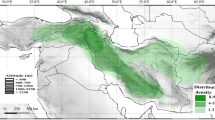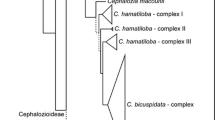Abstract.
Phylogenetic relationships of Cytisus and allied genera (Argyrocytisus, Calicotome, Chamaecytisus, Cytisophyllum, and Spartocytisus) were assessed by analysis of sequences of the nrDNA internal transcribed spacer (ITS) and the cpDNA trnL-trnF intergenic spacer. Genera of the Genista-group (Chamaespartium, Echinospartum, Genista, Pterospartum, Spartium, Teline and Ulex) were included to check the position of Cytisus species transferred to Teline. The tree obtained by combining both sets of data indicates that the Genista and Cytisus groups form two separate clades. Cytisus heterochrous and C. tribracteolatus are more closely related to the Cytisus-group, thus their transfer to Teline is not supported by molecular data. Cytisus fontanesii (syn. Chronanthos biflorus) groups with Cytisophyllum sessilifolium and Cytisus heterochrous within the Cytisus-group. Similarly, Argyrocytisus battandieri falls within the Cytisus-group as a well differentiated taxon. All these taxa seem to have early diverged from the Cytisus-group. Their taxonomic rank should be reconsidered to better reflect their phylogenetic separation from Cytisus. On the contrary, Chamaecytisus proliferus and Spartocytisus supranubius enter in the main core of Cytisus, and they should better be included in sections of Cytisus (sect. Tubocytisus and Oreosparton, respectively). Sect. Spartopsis is not monophyletic and the position of several species, currently included in this section, deserves reevaluation: C. arboreus aggregate is closely related to C. villosus (sect. Cytisus) and to Calicotome; C. striatus is closely related to Cytisus sect. Alburnoides; and the position of C. commutatus (incl. C. ingramii) remains unclear. The relationships and positioning of several minor taxa (C. transiens, C. megalanthus, and C. maurus) are also discussed.
Similar content being viewed by others
Author information
Authors and Affiliations
Additional information
Received November 22, 2001; accepted March 16, 2002 Published online: October 14, 2002
Addresses of the authors: Paloma Cubas (e-mail: cubas@farm.ucm.es) and Cristina Pardo (e-mail: cpardo@farm.ucm.es), Departamento de Biología Vegetal II, Facultad de Farmacia, Universidad Complutense, E-28040 Madrid, Spain. Hikmat Tahiri Faculté des Sciences, Université Mohammed V, BP 1014 Rabat, Morocco (e-mail: tahiri@ fsr.ac.ma).
Rights and permissions
About this article
Cite this article
Cubas, P., Pardo, C. & Tahiri, H. Molecular approach to the phylogeny and systematics of Cytisus (Leguminosae) and related genera based on nucleotide sequences of nrDNA (ITS region) and cpDNA (trnL-trnF intergenic spacer). Plant Syst. Evol. 233, 223–242 (2002). https://doi.org/10.1007/s00606-002-0194-0
Issue Date:
DOI: https://doi.org/10.1007/s00606-002-0194-0




